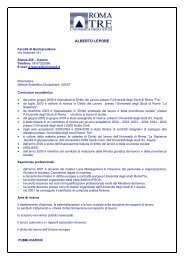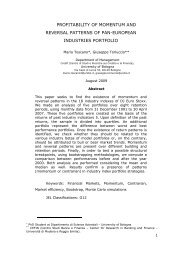large debt financing syndicated loans versus corporate bonds
large debt financing syndicated loans versus corporate bonds
large debt financing syndicated loans versus corporate bonds
You also want an ePaper? Increase the reach of your titles
YUMPU automatically turns print PDFs into web optimized ePapers that Google loves.
issuance costs are considered. It is also probably easier for a <strong>large</strong>r firm to raise<br />
external <strong>financing</strong> on top of bilateral <strong>debt</strong> arrangements.<br />
Therefore, it is more likely that smaller and medium-size firms meet their <strong>financing</strong><br />
needs through private <strong>debt</strong> and bilateral bank <strong>loans</strong>. Firms with greater financial<br />
leverage are less likely to tap both markets. A high ex ante probability of financial<br />
stress forces them to refrain from both markets due to renegotiation concerns. Perhaps<br />
a choice of <strong>debt</strong> instrument with a single creditor (i.e. private finance or bilateral bank<br />
<strong>loans</strong>) will increase a firm’s possibility to renegotiate the terms of <strong>debt</strong> agreement<br />
effectively. Our findings also show that concerns about inefficient liquidation<br />
discourages firms from raising finance in the <strong>syndicated</strong> loan and bond markets.<br />
Variables signifying the growth potential of a firm are generally positively related to<br />
the probability of using the bond and <strong>syndicated</strong> loan markets.<br />
The two variables displaying different signs in estimated coefficients are current ratio<br />
and profitability: firms with high growth options measured by sales or the market-to-<br />
book value are more likely to use the bond markets. 12 Results also show that a higher<br />
level of current assets is attached to the preference of bond markets.<br />
Overall, the motivation to use the <strong>syndicated</strong> loan markets is not different from that to<br />
use the bond markets when the <strong>large</strong>r sample with smaller firms is employed.When<br />
<strong>syndicated</strong> <strong>loans</strong> are considered as a part of the <strong>debt</strong> options spectrum for all firms,<br />
regardless of size, the motivation of firms tapping these two alternative markets is<br />
found to be broadly similar. This result vouches for the need to consider both external<br />
<strong>financing</strong> alternatives (<strong>syndicated</strong> <strong>loans</strong> and <strong>corporate</strong> <strong>bonds</strong>) when considering the<br />
determinants of external <strong>financing</strong>.<br />
12 In the literature, variables for growth options are also used to measure asymmetric information<br />
related to moral hazard and agency costs.<br />
26 ECB<br />
Working Paper Series No 1028<br />
March 2009

















